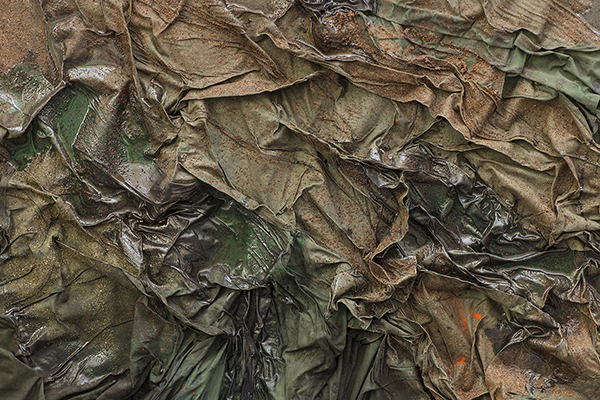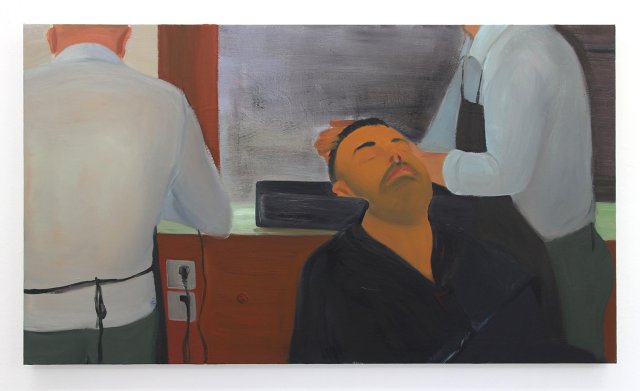Lateral Recovery Position

- Dala Nasser, Untitled (detail), 2018. 160 x 195cm. Discarded fabric, survival blankets, coal, glitter, liquid latex, resin, chrome orange and DPP orange pigments. Courtesy the artist.
Lateral recovery position (Position latérale de sécurité)
From January 30 through April 20, 2019
Opening on Tuesday, January 29, from 6 to 9 p.m.
with Thelma Cappello, Xinyi Cheng, Nathanaëlle Herbelin, Liverpool Black Women Filmmakers & Rehana Zaman, Georgia Lucas-Going, Adrian Mabileau Ebrahimi Tajadod, Dala Nasser, Kameelah Janan Rasheed, Hamid Shams, Patrick Staff
Curated by Guslagie Malanda & Lucas Morin
Bétonsalon - Center for Art and Research is pleased to present Lateral Recovery Position (Position latérale de sécurité), a collective exhibition that questions the place of violence and conflict in social and political spheres. The ten artists presented in this exhibition explore the connection between affects and violence, with an emphasis on how it is embodied in singular and intimate narratives. The exhibition presents both new works and existing works that have been adapted to the space. It is the first time that the works of Liverpool Black Women Filmmakers & Rehana Zaman, Georgia Lucas-Going, Dala Nasser, Kameelah Janan Rasheed, and Patrick Staff have been exhibited in France.
Be it social or physical, violence is a controversial mode of discourse that highlights societies and individuals in conflict. Violence marks a break in dialogue and the establishment of new relationships of strength, domination, and resistance that places those implicated in a position where neutrality is no longer possible. Be it violence through class, race, or gender, one will always be a victim or an accomplice, but never an innocent bystander. Artists aren’t above this relationship but are part of it, giving them a certain degree of responsibility.
The artists participating in Lateral Recovery Position (Position latérale de sécurité) explore the role and the construction of violence in their societies. They question the legitimacy of those who exercise it, blurring the binary status of victim and perpetrator. Each of the works looks at, with various degrees of engagement, conflicts that artists do not shy away from watching. They choose to take a close look at bodies and emotions, understanding them as intimate spaces where violence and power struggles unfold.

- Xinyi Cheng, Coiffeur, 2017, oil on linen, 80 × 140cm. Courtesy the artist and Balice-Hertling gallery, Paris.
The exhibition establishes formal dialogues between young and established artists, provoking intimate and personal exchanges. The artworks presented here fuel much needed conversations between artists influenced by queer and feminist theory, in the context of a French scene that struggles to adapt those concepts and practices.
Certain works focus on collective political practices, including the video How Does an Invisible Boy Disappear?, produced by the collaboration between artist collective Liverpool Black Women Filmmakers and artist Rehana Zaman. The work deals with racial and urban violence in England; building on the personal stories, fears, and desires of a group of teenagers from the low-income neighborhood of Toxteth, Liverpool. Artist, poet and educator Kameelah Janan Rasheed covers the large windows of Bétonsalon with slogan-poems that challenge the public directly, countering narratives that deny oppressed groups the legitimacy of their rage. The paintings of Xinyi Cheng and Nathanaëlle Herbelin connect bodies with their environment, paying attention to the everyday gestures, power plays, and tragedies that they experience. Patrick Staff’s film, depollute, unflinchingly looks at the materialization of politics in violence done to one’s own body. Georgia Lucas-Going’s performative short videos make use of a scathing and personal humor that simultaneously counterbalances and supports the gravity of the themes evoked; a humorous manner also present in the sculptural installations of Thelma Cappello and Adrian Mabileau Ebrahimi Tajadod. In Hamid Shams’ Comfort Zone, an installation made of urinals and a delicate back-room sling highlights the ambiguity of the concepts of domination and submission, through an environment both public and domestic. Finally, Dala Nasser’s abstract banners offer a more distant but no less incisive look at the raw materials that make up violence in the world.
Lateral Recovery Position is sponsored by Fluxus Arts Projects, a Franco-British program for contemporary art supported by the French Ministry of Culture and Communication, the Institut français, and the British Council.
Share